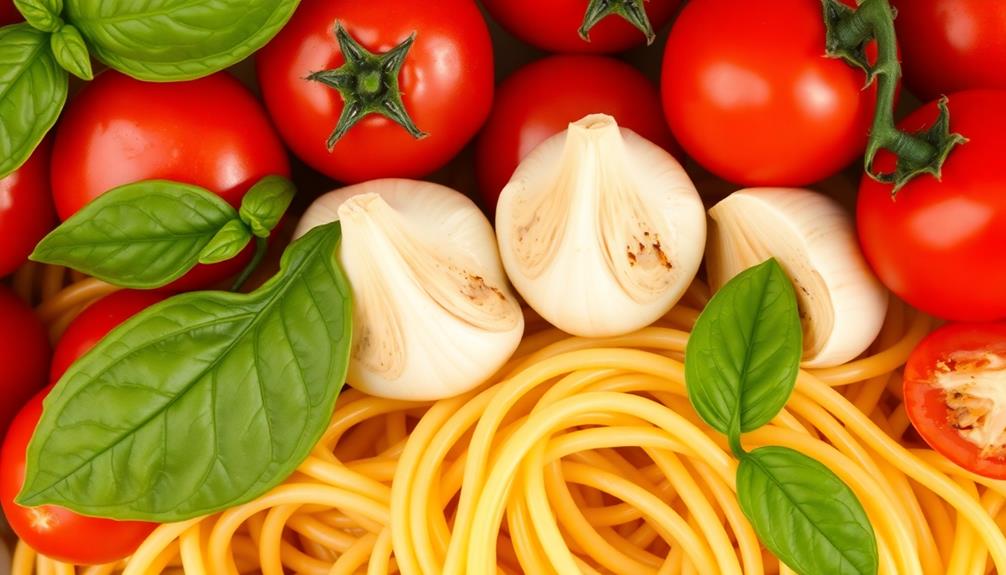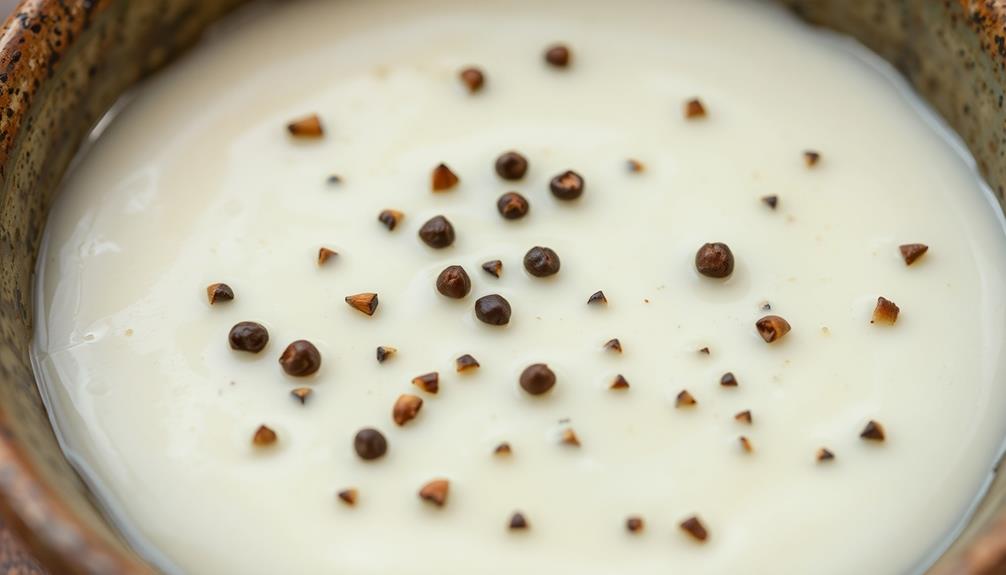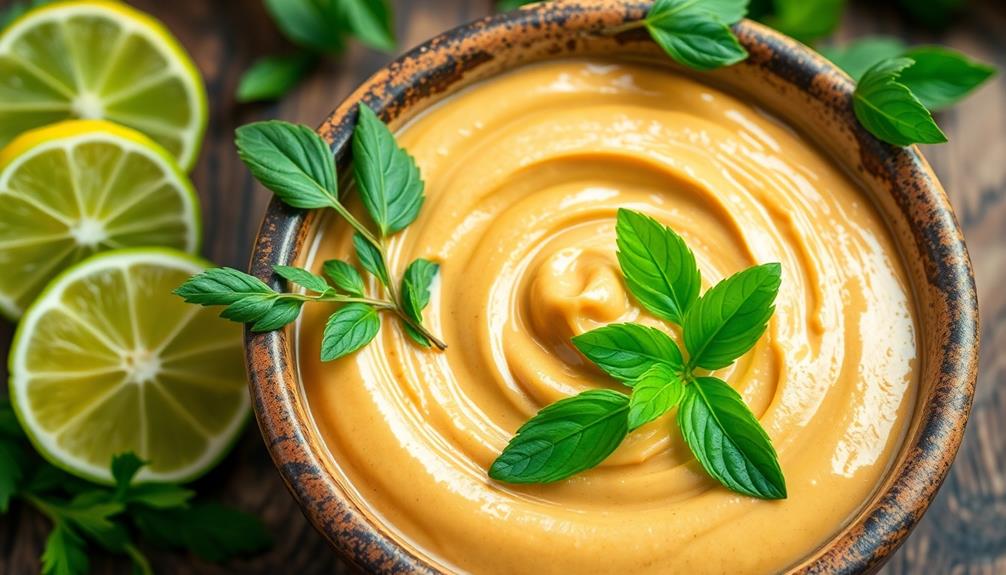You'll love how easy it is to whip up this raw marinara sauce! Its origins trace back hundreds of years to Italian sailors who crafted this tasty tomato-based delight using fresh, simple ingredients. Just combine juicy tomatoes, aromatic onions and garlic, flavorful basil, and a few other pantry staples. Let it marinate for a bit to meld the flavors, then blend to your desired consistency. Serve it over pasta, use it as a dip, or drizzle it on grilled meats and veggies – the possibilities are endless! Get ready to savor the bold, healthy flavors of this classic Italian sauce. You'll want to keep reading to discover even more delicious ways to enjoy it.
Key Takeaways
- Raw marinara sauce is a versatile, fresh, and healthy alternative to traditional cooked sauces, made with simple ingredients like tomatoes, herbs, and olive oil.
- The origins of raw marinara sauce can be traced back to 16th century Campania, Italy, where Italian sailors created it using fresh ingredients during long voyages.
- The recipe for raw marinara sauce is easy to make, requiring only a short marination time to allow the flavors to meld, and can be served over pasta or used as a dipping sauce.
- Raw marinara sauce is packed with vitamins and antioxidants from the fresh tomatoes, making it a low-calorie, nutritious option suitable for a balanced diet.
- Serving suggestions for raw marinara sauce include pairing it with various pasta types, using it as a topping for grilled proteins, or incorporating it into vegetable dishes and salads.
History

The origins of marinara sauce can be traced back to the 16th century in the Campania region of Italy. This beloved tomato-based sauce was first created by Italian sailors, who'd bring it with them on long voyages at sea.
They'd toss together whatever fresh ingredients they'd on hand – juicy tomatoes, fragrant herbs, and a splash of olive oil. The technique of combining simple, fresh ingredients mirrors the ancient culinary traditions seen in the use of butter's versatility, which has been cherished for its rich flavor and adaptability.
When they returned to the shore, the locals fell in love with this simple, yet delicious sauce. Over time, the recipe evolved, with families adding their own special touches.
Today, marinara sauce is a staple in Italian cuisine, found in households and restaurants across the world. Whether you're topping pasta, dipping bread, or using it as a base for other dishes, the rich, tangy flavor of marinara is sure to delight your taste buds.
Its history is as flavorful as the sauce itself!
Recipe

Raw Marinara Sauce
The beauty of this raw marinara sauce lies in its simplicity and vibrant flavor. By using fresh, ripe tomatoes and a few key ingredients, you can create a sauce that bursts with the essence of summer.
This raw sauce isn't only delightfully easy to make, but it also preserves the natural sweetness and texture of the tomatoes, making it a perfect pairing with fermented vegetable plates for a healthful meal. Enjoy it over pasta, as a dip for crusty bread, or even as a topping for grilled meats or vegetables.
- 5 pounds ripe tomatoes, diced
- 1 red onion, finely chopped
- 3 cloves garlic, minced
- 1/4 cup fresh basil leaves, chopped
- 2 tablespoons olive oil
- 1 tablespoon balsamic vinegar
- 1 teaspoon sea salt
- 1/4 teaspoon black pepper
Combine all the ingredients in a large bowl and gently mix until well incorporated. Allow the sauce to sit at room temperature for 30 minutes to 1 hour, allowing the flavors to meld. Serve immediately or refrigerate for up to 3 days.
When choosing the tomatoes, opt for a variety that's flavorful and juicy, such as heirloom or Roma. The key is to use the freshest, ripest tomatoes you can find for the best possible flavor.
Adjust the seasoning to your taste, adding more salt, pepper, or vinegar as desired.
Cooking Steps

Alright, let's get chopping! First, you'll want to dice up those tomatoes and remove the seeds. Fresh tomatoes are packed with antioxidants that can combat oxidative stress, making this sauce not only delicious but also a healthful addition to your meal.
Next, mince the garlic, onion, and basil. Now, add a squeeze of lemon juice and a drizzle of olive oil, and let the tomato mixture marinate for a bit. This combination is great for enhancing flavor and can also aid in liver health by reducing enzyme levels coffee's health benefits.
Then, you're ready to serve this raw marinara sauce over your favorite pasta – yum!
Step 1. Dice Tomatoes, Remove Seeds

To begin, dice the tomatoes and remove their seeds. This is an important first step in making your raw marinara sauce. Use a sharp knife to carefully cut the tomatoes into small, evenly-sized pieces. As you slice, gently scoop out the seeds and pulp with a spoon. It's best to discard the seeds, as they can make the sauce taste bitter.
Next, place the diced tomato pieces into a bowl. You'll want to have about 2 cups of diced tomatoes when you're done. If you have any extra, you can save them for another recipe.
Removing the seeds helps create a smooth, thick sauce without any unwanted crunchiness. Dicing the tomatoes also allows them to break down more easily as the sauce marinates.
With the prep work complete, you're now ready to move on to the next step – mixing the sauce! Just wait until you smell the fresh, tangy aroma.
Step 2. Mince Garlic, Onion, and Basil

After dicing the tomatoes, mince the garlic, onion, and fresh basil. You'll want to chop them up nice and small so they blend right into the sauce.
First, peel the garlic and give it a good whack with the flat side of your knife. This will loosen the peel so you can slip it right off. Toss the naked garlic cloves onto your cutting board and start slicing them up, moving the knife back and forth to create those tiny, fragrant pieces.
Next, grab your onion and slice it in half from root to stem. Carefully peel off the papery skin, then chop the onion into small, even bits. Don't be afraid to get a little teary-eyed – it's all part of the process!
Finally, gently pluck the basil leaves from their stems and stack them up. Run your knife through the pile, slicing the leaves into thin ribbons.
With the aromatics all minced, you're ready to add them to your diced tomatoes and create a delicious, raw marinara sauce!
Step 3. Add Lemon Juice and Olive Oil

With the aromatics minced and ready to go, let's add a few more key ingredients to really bring this raw marinara sauce to life.
First up, a good squeeze of fresh lemon juice. This'll add a delightful zing that'll wake up your taste buds and complement the other flavors perfectly. Lemon's also a natural preservative, so it'll help keep your sauce nice and fresh.
Next, drizzle in a generous amount of high-quality olive oil. Not only does it lend a lovely richness, but the healthy fats in olive oil help your body absorb all the vitamins and minerals from the veggies.
Plus, the oil will create a silky, luxurious texture. Go ahead, give it a good stir and take a whiff – mmm, can you smell that Mediterranean magic already?
With the lemon and olive oil incorporated, your raw marinara sauce is really starting to come together now.
Time to move on to the next step!
Step 4. Let Tomato Mixture Marinate

Now that you've added the lemon juice and olive oil, let the tomato mixture marinate for 15-30 minutes. This allows all the flavors to meld together, making the sauce even more delicious.
During this time, the acids in the lemon juice will help break down the tomatoes, creating a silky-smooth texture. The olive oil will also infuse the mixture with its fruity, robust flavor.
As the tomatoes marinate, you can take a moment to admire the beautiful colors – the deep red of the tomatoes, the vibrant green of the herbs, and the golden hue of the olive oil.
Inhale the tantalizing aroma, which will have your taste buds eagerly anticipating the first bite. When the time is up, give the mixture a gentle stir to ensure everything is well combined.
Now you're ready to move on to the next step – blending the sauce to perfection! Get excited, because this homemade marinara is about to take your taste buds on a flavor adventure.
Step 5. Serve Immediately Over Pasta

Once the tomato mixture has marinated, it's time to blend the sauce to perfection. Grab your high-powered blender and add the marinated tomatoes, garlic, basil, and any other seasonings you'd like. Give it a good whirl until the sauce is smooth and creamy.
Don't worry if it's a bit chunky – that's part of the charm of a raw marinara!
Now, it's time to serve this delicious sauce. Cook up your favorite pasta according to the package instructions. Whether you prefer spaghetti, penne, or even zucchini noodles, the marinara will be the star of the show.
Ladle the vibrant red sauce over the hot, freshly cooked pasta and enjoy. The flavors will dance on your taste buds, transporting you straight to the heart of Italy.
Don't forget to sprinkle on a bit of fresh basil or Parmesan cheese for an extra special touch. Buon appetito!
Final Thoughts

This raw marinara sauce recipe is a delightful and straightforward way to enjoy the vibrant flavors of fresh tomatoes.
You'll be amazed at how quickly you can whip up this tasty sauce without any cooking involved! The best part is that it's packed with nutrients from the raw ingredients, making it a healthy option for your pasta night.
Once you've blended everything together, simply pour the sauce over your favorite pasta, and you've got a delicious, nutritious meal.
Don't be afraid to get creative and experiment with different herbs or spices to suit your taste buds. This raw marinara is also a fantastic dipping sauce for breadsticks or as a topping for grilled chicken or fish.
The possibilities are endless! So, give this recipe a try, and enjoy the fresh, vibrant flavors of homemade marinara without the hassle of cooking.
Your taste buds will thank you!
Frequently Asked Questions
How Long Does Raw Marinara Sauce Keep in the Refrigerator?
Typically, raw marinara sauce will keep for 3-5 days in the refrigerator. Be sure to store it in an airtight container, and always check for signs of spoilage before using. Proper refrigeration helps maintain its freshness and flavor.
Can Raw Marinara Sauce Be Frozen for Later Use?
Yes, you can freeze raw marinara sauce for later use. Simply pour the sauce into airtight containers or freezer bags, label them with the date, and store them in the freezer for up to 3 months.
What Are the Best Ways to Serve Raw Marinara Sauce?
You can serve raw marinara sauce in a variety of ways. Toss it with hot pasta, use it as a dipping sauce for crusty bread, or even spoon it over grilled chicken or fish. Get creative and enjoy the fresh flavors!
Can Raw Marinara Sauce Be Used as a Dip or Spread?
Absolutely! You can use raw marinara sauce as a versatile dip or spread. Its tangy flavor and thick consistency make it perfect for dipping breads, vegetables, or even as a topping for grilled meats or roasted potatoes.
Are There Any Variations or Substitutions for the Ingredients in Raw Marinara Sauce?
You can try variations like pesto, hummus, or guacamole as alternatives to raw marinara sauce. These offer different flavors and textures that can work well as dips or spreads. Get creative with your ingredient substitutions to find what suits your tastes best.
















